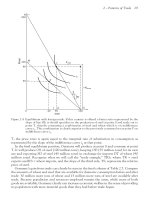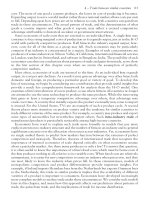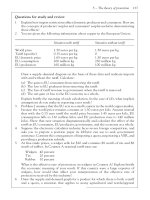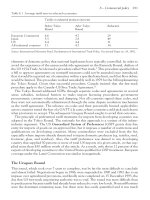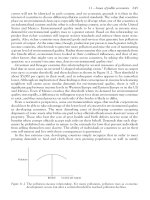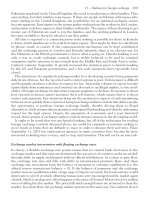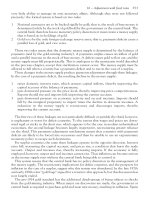International economics 6th edition james gerber test bank
Bạn đang xem bản rút gọn của tài liệu. Xem và tải ngay bản đầy đủ của tài liệu tại đây (169.41 KB, 11 trang )
International Economics, 6e (Gerber)
Chapter 2 International Economic Institutions Since World War II
2.1 Introduction: International Institutions and Issues Since World War II
1) Institutions are
A) the same thing as organizations.
B) associations of individuals or groups.
C) always embodied in a written set of rules.
D) a set of rules governing behavior, whether written or not.
E) only relevant on international issues.
Answer: D
Topic: Introduction: International Institutions and Issues Since World War II
2) Which of the following is an example of an institution whose primary concern is global
stability?
A) NAFTA (North American Free Trade Agreement)
B) OPEC (Oil Producing and Exporting Countries)
C) IMF (International Monetary Fund)
D) Mekong River Commission
E) Asian Development Bank
Answer: C
Topic: Introduction: International Institutions and Issues Since World War II
3) Many of the important international governmental institutions that deal with the global
economy have their roots in the Bretton Woods conference at the end of World War II.
Answer: TRUE
Topic: Introduction: International Institutions and Issues Since World War II
2.2 The IMF, the World Bank, and the WTO
1) The international organization that serves as a forum for trade discussions and the
development of trade rules is called
A) the WTO.
B) the World Bank.
C) the IMF.
D) Bretton Woods.
E) the United Nations.
Answer: A
Topic: The IMF, the World Bank, and the WTO
1
Copyright © 2014 Pearson Education, Inc.
2) Which of the following was NOT a creation of the Bretton Woods conference?
A) World Bank
B) IMF
C) IBRD
D) WTO
E) None of the above.
Answer: D
Topic: The IMF, the World Bank, and the WTO
3) One of the strongest motivations for holding the Bretton Woods Conference was to design
new international institutions that would
A) contain communism.
B) help countries avoid the mistakes of the 1920s and 1930s.
C) provide a collective defense security for Western Europe and North America.
D) ensure that world prices were not rising too rapidly.
E) create a single currency in Western Europe.
Answer: B
Topic: The IMF, the World Bank, and the WTO
4) One of the most important and most visible roles of the IMF is to
A) hold regular negotiations over tariff reductions.
B) investigate countries that are charged with being unfair traders.
C) provide loans to countries that need capital to develop their economies.
D) intercede by invitation when countries cannot pay their international debts.
E) serve as a forum for negotiating free trade agreements between groups of nations.
Answer: D
Topic: The IMF, the World Bank, and the WTO
5) The original mission of the World Bank was to
A) provide capital to underdeveloped countries.
B) provide capital to firms around the world.
C) provide financial assistance for the reconstruction of war-damaged nations.
D) provide a safe place for people around the world to put their money.
E) help countries manage their exchange rates.
Answer: C
Topic: The IMF, the World Bank, and the WTO
6) The primary mission of the World Bank today is to
A) provide capital to underdeveloped countries.
B) provide capital to firms around the world.
C) provide financial assistance for the reconstruction of war-damaged nations.
D) provide a safe place for people around the world to put their money.
E) help countries manage their exchange rates.
Answer: A
Topic: The IMF, the World Bank, and the WTO
2
Copyright © 2014 Pearson Education, Inc.
7) From the late 1940s until the creation of the WTO, the organization that was primarily
responsible for conducting rounds of trade negotiations was the
A) World Bank.
B) IMF.
C) ITO.
D) United Nations.
E) GATT.
Answer: E
Topic: The IMF, the World Bank, and the WTO
8) Until the Uruguay Round of trade negotiations, which of the following sectors were NOT
included in the rules for international trade?
A) Steel and agriculture
B) Automobiles and electronics
C) Agriculture and apparel
D) Steel and textiles
E) Automobiles and agriculture
Answer: C
Topic: The IMF, the World Bank, and the WTO
9) Most favored nation (MFN) status means that a country treats another country
A) better than its other trading partners.
B) the same as its other trading partners.
C) worse than its other trading partners.
D) any way it chooses since it is the "most favored nation."
E) None of the above.
Answer: B
Topic: The IMF, the World Bank, and the WTO
10) When the United States gives MFN status to China, it means that
A) China is treated better than other U.S. trading partners.
B) China is treated the same as other U.S. trading partners.
C) China is treated worse than other U.S. trading partners.
D) China is better than all the nations in the WTO.
E) China is legally bound to reciprocate.
Answer: B
Topic: The IMF, the World Bank, and the WTO
3
Copyright © 2014 Pearson Education, Inc.
11) The Tokyo Round of the GATT negotiations was notable because it was the first round
A) that included Japan.
B) that included textiles and apparel.
C) to begin establishing rules on subsidies.
D) to begin discussions of exchange rates.
E) to limit the tariffs of the United States.
Answer: C
Topic: The IMF, the World Bank, and the WTO
12) IMF conditionality refers to the
A) technical assistance the IMF gives.
B) minimum size of a national debt problem that a country must have before the IMF gets
involved.
C) minimum-sized loan the IMF will make.
D) maximum-sized loan the IMF will make.
E) changes a country must make in order to receive IMF financial assistance.
Answer: E
Topic: The IMF, the World Bank, and the WTO
13) Which of the following is TRUE?
A) A country experiencing a debt or currency crisis would contact the World Trade
Organization.
B) The World Trade Organization was formed at the Bretton Woods conference.
C) The General Agreement on Tariffs and Trade created the World Trade Organization in the
negotiations and treaty known as the Uruguay Round.
D) The World Trade Organization has no power to resolve trade disputes and to enforce their
resolution.
Answer: C
Topic: The IMF, the World Bank, and the WTO
14) Having MFN status means that the country is getting the most favorable trade terms possible
with a trading partner.
Answer: FALSE
Topic: The IMF, the World Bank, and the WTO
15) A country experiencing a debt or currency crisis would contact the World Bank.
Answer: FALSE
Topic: The IMF, the World Bank, and the WTO
16) The World Bank was created as a result of the Bretton Woods conference and was originally
focused on the reconstruction of Europe after World War II.
Answer: TRUE
Topic: The IMF, the World Bank, and the WTO
4
Copyright © 2014 Pearson Education, Inc.
17) The IMF, because it can force nations to take loans and bail out packages, has more power
than other international governmental organizations dealing with the global economy.
Answer: FALSE
Topic: The IMF, the World Bank, and the WTO
18) The World Bank formed the World Trade Organization when it became clear that to alleviate
poverty in developing nations, agricultural trade barriers were going to have to be reduced.
Answer: FALSE
Topic: The IMF, the World Bank, and the WTO
19) A nation's votes at the IMF are proportional to its population.
Answer: FALSE
Topic: The IMF, the World Bank, and the WTO
20) MFN status means that a trading partner is getting the best trade deal possible given current
national trade policies.
Answer: FALSE
Topic: The IMF, the World Bank, and the WTO
21) WTO talks in the late 1990s led to openings in both financial services and
telecommunications.
Answer: TRUE
Topic: The IMF, the World Bank, and the WTO
22) Describe the primary functions of the World Bank, the IMF, and the WTO. When was each
of these organizations formed?
Answer: The IMF and the World Bank were outlined at the Bretton Woods Conference and
began operations at the end of World War II. Both function as banks for national governments,
with the IMF playing the role of lender of last resort and the World Bank focusing its loans on
economic development. A nation facing a payments crisis can contact the IMF for a loan, but it
may have to change its domestic policies as part of the price of the loan package. The World
Bank initially focused its lending on rebuilding war-torn areas, but then broadened its focus to
development. Only developing countries can borrow from the World Bank.
The World Trade Organization was not formed until 1994. An international organization to
establish rules related to world trade, business practices, and international investment was
proposed at the end of World War II, but was not created. A series of trade negotiations that
focused primarily on lowering tariffs were launched. A number of rounds of GATT were
completed and ultimately the round known as the Uruguay Round led to the formation of the
WTO. The WTO focuses on the multilateral resolution of trade disputes and on continued
negotiations to further reduce barriers to trade.
Topic: The IMF, the World Bank, and the WTO
5
Copyright © 2014 Pearson Education, Inc.
23) What is MFN status? How does the WTO reconcile the principle of equal treatment with the
preferential treatment created by regional trade agreements?
Answer: MFN status is basically that you will treat all nations participating in the agreement the
same. A regional trade agreement creates preferential treatment for nations that are participants.
(For example, because of NAFTA, Mexico and Canada get more preferential terms with the
United States than other WTO members would.) The WTO recognizes that regional agreements
destroy some opportunities for trade (by making nonmembers face higher barriers than
members), but believes they create more trade between participants than they destroy. The
regional agreements also allow nations to try out new arrangements that may later be adopted
more broadly.
Topic: The IMF, the World Bank, and the WTO
24) Trade policies in which industries have been the most contentious in the Doha Round?
Answer: Agriculture and services
Topic: The IMF, the World Bank, and the WTO
25) Which round of GATT first addressed subsidies?
Answer: The Tokyo Round
Topic: The IMF, the World Bank, and the WTO
26) What result of the Uruguay Round was the most significant for global trade?
Answer: The creation of the WTO
Topic: The IMF, the World Bank, and the WTO
27) How is the IMF funded?
Answer: It collects fees called quotas from it members.
Topic: The IMF, the World Bank, and the WTO
28) The IBRD part of the World Bank is set up to lend to whom and for what types of projects?
Answer: Developing nations' governments for specific development projects or major
government economic policy adjustments
Topic: The IMF, the World Bank, and the WTO
29) Which round of GATT led to the formation of the WTO?
Answer: The Uruguay Round
Topic: The IMF, the World Bank, and the WTO
6
Copyright © 2014 Pearson Education, Inc.
2.3 Regional Trade Agreements
1) A free trade agreement plus a common set of tariffs toward non-members is called
A) a common market.
B) a customs union.
C) a free trade area.
D) an economic union.
E) a partial trade agreement.
Answer: B
Topic: Regional Trade Agreements
2) Which of the following is FALSE?
A) A common market is more deeply integrated than an economic union.
B) NAFTA is an example of a free trade area.
C) The European Union is a deeper form of integration than NAFTA.
D) Common markets allow for labor mobility between participating nations.
Answer: A
Topic: Regional Trade Agreements
3) Which of the following is TRUE?
A) A common market is more deeply integrated than a customs union.
B) The European Union is a shallower and broader form of integration than NAFTA.
C) NAFTA is an example of a customs union.
D) Customs unions require the creation of a common currency.
Answer: A
Topic: Regional Trade Agreements
4) Which of the following is NOT a feature of a common market?
A) Substantial coordination of macroeconomic policies among the members
B) Free trade in goods and services between the members
C) Common external barriers to trade
D) Factor mobility
Answer: A
Topic: Regional Trade Agreements
5) Which of the following is a problem that arises when trying to classify regional trade
agreements?
A) Many agreements combine elements from different categories.
B) The definition of free trade area includes that of a customs union.
C) Some agreements include cultural issues while others do not.
D) The most favored nation clause includes all of them.
E) None of the above.
Answer: A
Topic: Regional Trade Agreements
7
Copyright © 2014 Pearson Education, Inc.
6) With a partial trade agreement
A) goods and services are allowed to cross boundaries without tariffs.
B) two or more countries agree to liberalize trade in a selected group of categories.
C) two or more countries set common tariffs toward non-members.
D) two or more countries allow the free mobility of inputs such as labor and capital.
E) two or more countries agree on establishing a common currency.
Answer: B
Topic: Regional Trade Agreements
7) Describe the potential benefits and the potential costs to global trade of the tremendous
growth in regional trade agreements.
Answer: A regional trade agreement creates preferential treatment for nations that are
participants, which violates the idea of MFN status in multilateral agreements, where nations
agree to treat all participants the same. The WTO recognizes that regional agreements destroy
some opportunities for trade by making non-members face higher barriers than members of the
regional agreement. But it believes that they create more trade than they divert, and the regional
agreements allow nations to try out arrangements that may later be adopted more broadly.
Topic: Regional Trade Agreements
2.4 The Role of International Economic Institutions
1) One reason markets may fail to provide the optimal quantity of public goods is the problem of
A) determining what the public wants.
B) nontariff barriers.
C) nondiscrimination.
D) free riders.
E) economic integration.
Answer: D
Topic: The Role of International Economic Institutions
2) If a good or service does not get used up as it is consumed, then it is said to be
A) nonexcludable.
B) nonrival.
C) nondiscrimination.
D) nonconsumable.
E) None of the above.
Answer: B
Topic: The Role of International Economic Institutions
8
Copyright © 2014 Pearson Education, Inc.
3) An important function of international institutions during times of crisis is to
A) make goods nonrival.
B) make goods nonexcludable.
C) prevent free riding.
D) prevent nondiscrimination.
E) encourage free riding.
Answer: C
Topic: The Role of International Economic Institutions
4) Which multilateral institution serves as the lender of last resort?
Answer: The IMF
Topic: The Role of International Economic Institutions
2.5 Criticism of International Institutions
1) Which of the following is NOT a criticism of international institutions such as the IMF, the
World Bank, or the WTO?
A) They lack openness in their decision-making process.
B) They violate national sovereignty by imposing unwanted domestic policies.
C) They fail to understand the effects of their policies on the vulnerable.
D) Their decision making is biased in favor of underdeveloped nations and against the interests
of nations already industrialized.
E) They ignore potentially large adjustment costs for developing nations of implementing their
policies.
Answer: D
Topic: Criticism of International Institutions
2) Which of the following criticisms is NOT directed to the IMF?
A) It lacks openness in its decision-making process.
B) It serves the interests of wealthier countries.
C) It creates a free-riding problem.
D) It violates national sovereignty.
E) It is heavily bureaucratic and at times gives harmful advice.
Answer: C
Topic: Criticism of International Institutions
9
Copyright © 2014 Pearson Education, Inc.
3) Which of the following is FALSE?
A) National sovereignty limits outsiders' ability to change the trade laws and practices of
individual nation states.
B) Because of international recognition of national sovereignty, individual nations are unaffected
by global trade and capital flows.
C) Foreign investors may not have a legal right to impose policies on a nation state, but the
nation state may still experience consequences of poor policies.
D) Because trade policies are laws of individual nations, it is difficult for other nations and
international organizations to force changes on unwilling nation states.
Answer: B
Topic: Criticism of International Institutions
4) Which of the following is FALSE about the International Monetary Fund (IMF)?
A) The IMF was created after the Bretton Woods Conference to help to maintain the
international fixed exchange rate system that was introduced.
B) The IMF lends to national governments, initially to maintain the fixed exchange rate system,
and today to deal with debt or currency crises.
C) Multinational corporations can get IMF loans if they agree to invest in economies that are
internationally perceived as risky and otherwise unlikely to receive direct foreign investment.
D) One of the criticisms of the IMF and other international governmental organizations that deal
with the global economy is that their decision making may be biased toward policies that favor
industrialized nations.
Answer: C
Topic: Criticism of International Institutions
5) Because of the recognition internationally of the principles of national sovereignty, nations
cannot be affected by the policies of other nations and international governmental organizations.
Answer: FALSE
Topic: Criticism of International Institutions
6) The majority of economists favor open capital flows.
Answer: FALSE
Topic: Criticism of International Institutions
10
Copyright © 2014 Pearson Education, Inc.
7) Describe the criticisms about decision making at the IMF and the World Bank. Which types
of policies are thought to reflect bias? What types of costs are not considered? What is the
fundamental question critics raise about the operations of the international governmental
economic institutions?
Answer: Voting structures at the IMF and World Bank give developed nations, and the U.S.
especially, control over decision making, making it hard to delineate whose interests are being
served. For example, policies favoring free capital flows and privatization of publicly owned
industries are thought to reflect the biases of industrialized countries rather than overwhelming
economic consensus. Implementation and adjustment costs may be much greater in developing
countries because they have higher overall levels of unemployment, less diversification in their
economies, and fewer resources to develop new infrastructure or to do other spending necessary
to take advantage of new opportunities. Fundamentally, critics ask whether they are fostering
development and economic security or generating greater economic inequality and compounding
risks to vulnerable groups.
Topic: Criticism of International Institutions
11
Copyright © 2014 Pearson Education, Inc.

